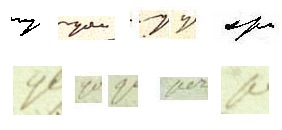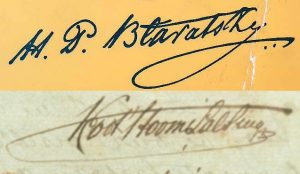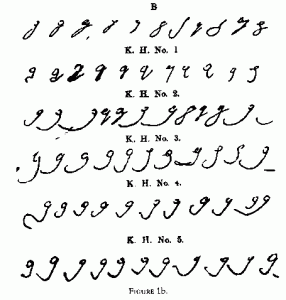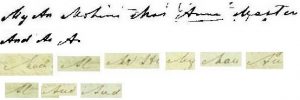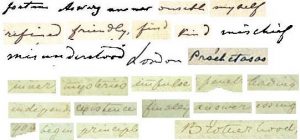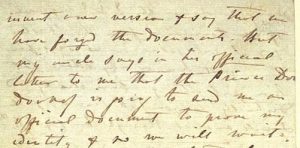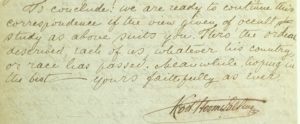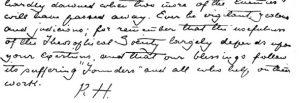HPB, Handwriting
and the Mahatma Letters, Part 4
The question now is, if I am correct that she did write the Mahatma letters in her own hand, what are we supposed to make of Madame Blavatsky? Was she then a complete fraud who should be totally rejected?
I certainly do not write her off, but instead look at her life and works as a whole. There are accounts in her life that testify that she must have had help at times from a supernatural source and her greatest work, The Secret Doctrine testifies to a knowledge beyond normal human understanding.
In addition to this, Djwhal Khul through Alice A. Bailey, acknowledged that she worked under the guidance of the Masters and performed a great work while at the same time realizing her flaw of forging the Mahatma Letters. He said:
The Master K.H., in one of the few (the very few) paragraphs in The Mahatma Letters which are genuine and not simply the work of H.P.B., gave a hint to aspirants of that time when He said that so many of them were so “spiritually selfish.”
Rays and Initiations, Page 342
It is indeed interesting then that DK tells us that only a few paragraphs of all the letters are the genuine words of a Master and the rest are “the work of HPB.”
Here is what I think led up to the fabrication. DK tells us that HPB was Count Alessandro Cagliostro in a past life and during that life did not live up to expectations in the service of the hierarchy, but yielding to glamour did much harm to the cause.
Evidently Cagliostro used some trickery and deception to promote his own agenda instead of the Hierarchy and this flaw carried over in part to her life as HPB. The difference was that she used some deception, not to promote her own will, but something greater than herself. She moved a step forward from the life of Cagliostro, but did not distance herself from all past flaws.
Here is what I think happened. HPB did receive some true contact from the Hierarchy and had a true sense of mission toward fulfilling a part of the Divine Will. As she went about her work she found it was difficult to gain and keep followers and the Hierarchy didn’t seem to be much help. She kept thinking that if they would just materialize a few miracles that it would be much easier to convince people. Unfortunately for her the Masters are not much into supporting glamour so they did not cooperate in the ways she wanted.
She therefore decided to give the work a kick in the pants by producing her own miracles. In her travels she had gained a number of secrets from various magicians and knew how to do a few tricks that would appear quite miraculous. She used her skill to make it seem as if the Mahatma Letters just materialized out of thin air as well as other tricks such as making other objects appear or be found at some strange location.
These seemingly outward miracles did help her convince followers that she was in contact with a higher source, but also had the negative effect of planting the seeds of glamour that affected many of her followers to this day.
You’ll notice that Alice A. Bailey working on behalf of DK did not ask for or produce any type of miracle that would appeal to glamour. She did produce one astounding miracle and that was to write many great words that were beyond her own intelligence to manifest. Thus the life of Alice A. Bailey did not plant seeds of glamor similar to HPB. That doesn’t mean all Alice A. Bailey students are free from glamour, but that she just didn’t feed such glamours.
Similarly, I think the one important miracle in the life of HPB was her connection to the Masters. I believe that most of her writings are in her own words, but she received many impressions and pictures in her mind of various words, quotes and sources for her writings.
I think the hierarchy understood Blavatsky’s flaws, but continued to work with her anyway because there was no one else that could get the job done.
None of the messengers or prophets of the past have been perfect. Look at the lives of David, Solomon, Jonah, Peter, Paul, Mohammed and others. They did great work despite their flaws.
Does this mean that I endorse their flaws?
No. We must all do all in our power to rise above such things for flawed people produce a work that will have seeds of its own destruction built in. Let the servants in this new age not let their own imperfection infect the work but move forward with no deceit in a spirit of harmlessness to promote truth verified by the Divine Self.
Copyright 2016 by J J Dewey
Index for Recent Posts – includes this series
Easy Access to All the Writings
For Free Book go HERE and other books HERE
JJ’s Amazon page HERE
Gather with JJ on Facebook HERE

